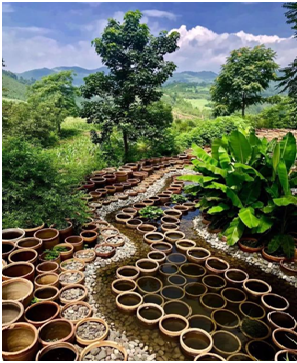By Bi Jingjin, People’s Daily
A remote and once poverty-stricken village in central China’s Henan province has turned prosperous and vital thanks to ceramic art.
In Huashu’aovillage, Luoning county, Luoyang city of Henan, big ceramic vats are seen everywhere. They are flowerpots, guard bars, and dustbins, as well as road signs and billboards in the village. Besides, they are also sometimes goods shelves in shops and tea tables in meeting rooms. Even the footpath in the village’s valleys is paved with vats.
There are 9,999 vats in the village, which were collected by GuoAihe, a renowned Chinese ceramic artist and curator of the Luoyang Sancai Art Museum.
Nine years ago, Guoand his family passed by the village during a road trip. “It’s a lovely village with a profound culture, and the villagers are hospitable,”Guo said.
At that time, Huashu’ao village barely saw any visitors and the majority of young residents were working out of town. The village was shabby and desolate in the eyes of the villagers, but Guo viewed it asan ideal place for art creation and a rich source of ceramic materials. “The village needs the revitalizing influence of art,”Guo said.
Therefore, Guo and some ceramic artists from the Luoyang Sancai Art Museum came to the village, and discovered the potential artistic value of the old houses and items that were deemed useless by the villagers.
They convertedthe old houses into exhibition halls, and covered ceramic tiles on earth walls to make the walls artistic. In addition, furnishing cave dwellings with artworks and coffee pots, they have transformed these cave dwellings into recreation facilities.
The artworks of sancaiceramic, or three-color glazed pottery, made by Guo and his team are all produced locally. They are used to decorate the old houses, earth walls, and cave dwellings in the village, Guo said. According to the man, fusing the ceramic art and the village and maintaining the original taste of the village is a major principle that he follows.
Guo told People’s Daily that not a single old house has been demolished by his team in the past seven or eight years, and every piece of farmland in the village is still used for growing crops today.
All the eight households in the village have built new houses, and some of them are even running B&B hotels as the village sees more and more visitors.
The government of Luoningcounty has invested 15 million yuan ($2.24 million) in constructing infrastructure, pavingasphalt roads, andplanting a wide area of oilseed and sunflowers
Guo is also subsidizing the villagers. The income from the wheat grown in the village all goes to the villagers and the latter also get subsidies for their rented old houses and cave dwellings. Guo pays some villagers to prepare food for visitors and has promised that only villagers are allowed to run B&B hotels and restaurants.
As the number of visitors increases, many villagers have returned to their hometown and started running B&B hotels. Some of them are also engaged in construction maintenance, road maintenance and lawn cutting services.
Guo and his team have more ambitious plans. Guo said every minute he is thinking about how he can make the village more artistic and thus bring more benefits to the villagers.
“To advance rural vitalization through art is feasible here. I hope this village can become a catalyzer that helps improve villagers’ artistic taste and promote art-driven rural vitalization,” he said.












